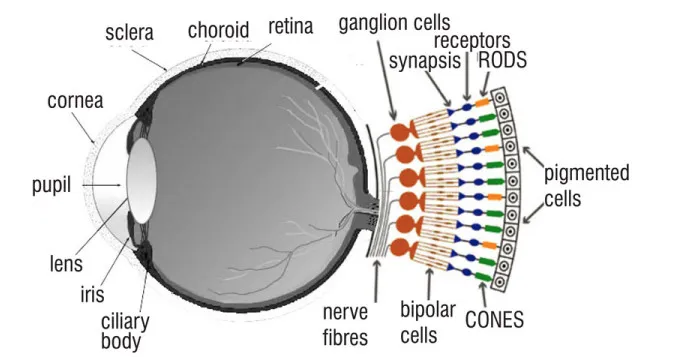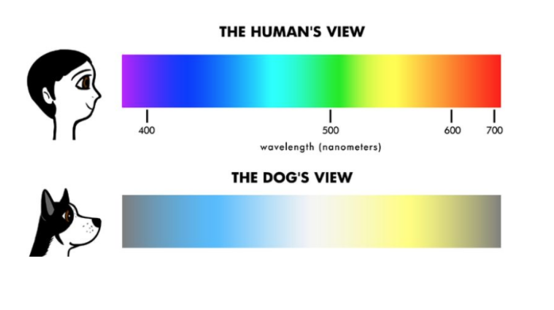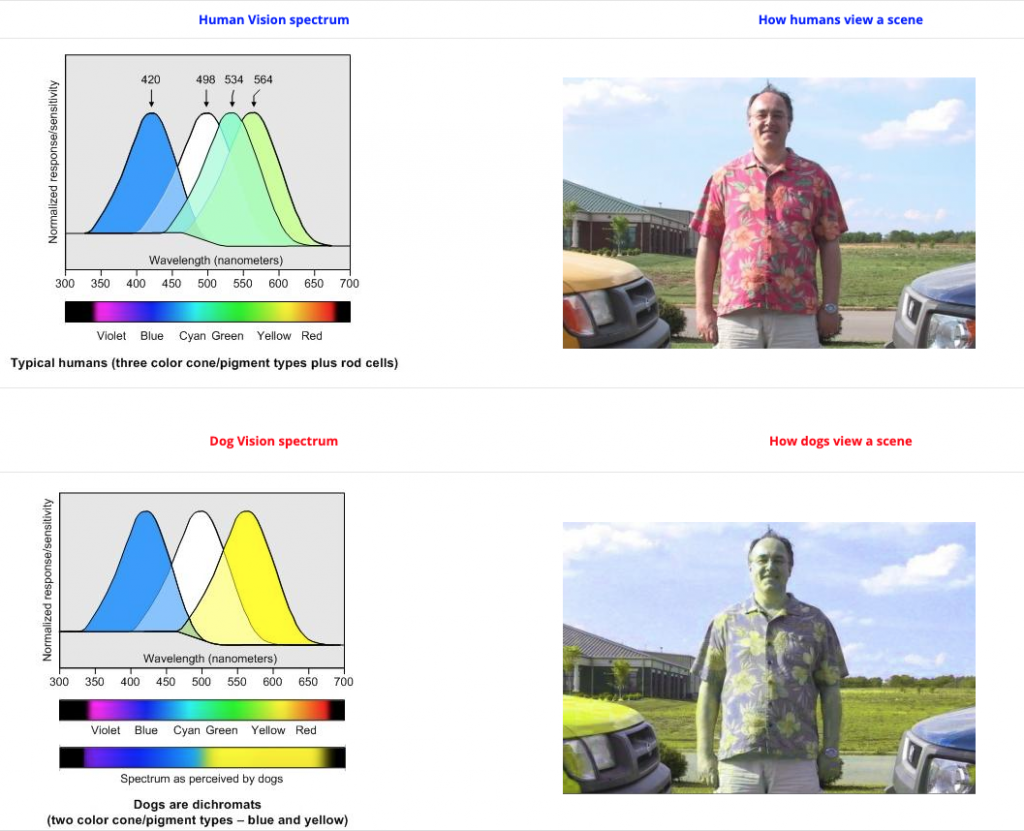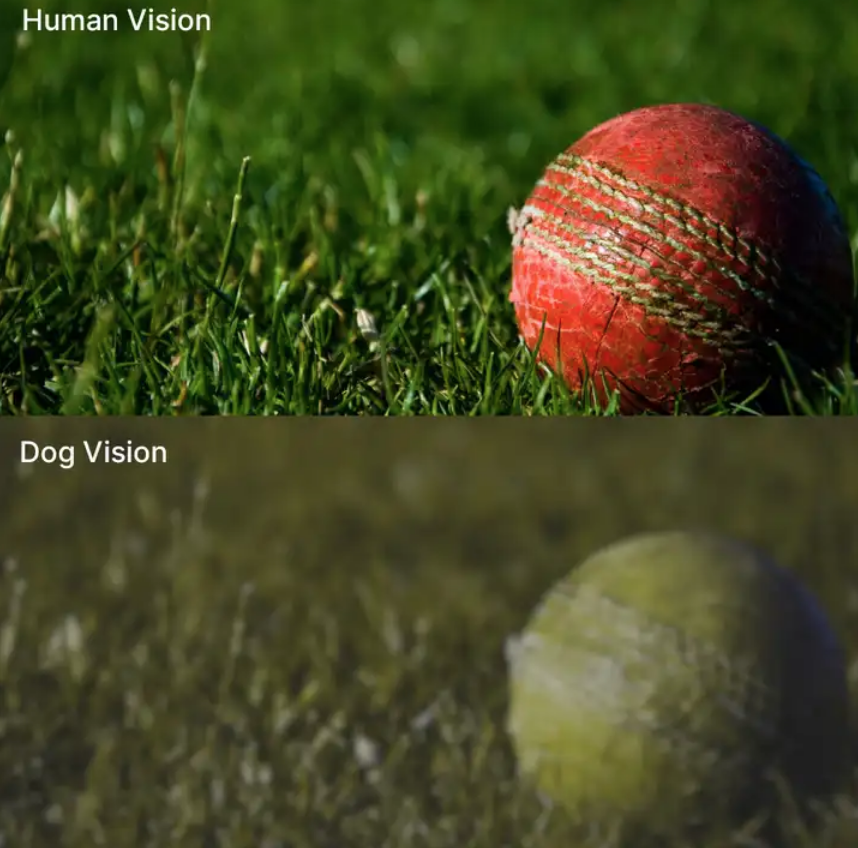Are Dogs Color Blind?

You might have heard the myth that dogs only see the world in black and white, but that’s not exactly true. While dogs can’t see all the colors that we can, your best friend certainly sees many of the colors of life.
What colors do dogs see?
Dogs see yellow, blue, green, and mixes of those colors. Scroll to the bottom to find out which color dogs are completely blind to.
Dogs’ color vision is different than ours due to the internal structure of the eye itself. So let’s get into the science behind why dogs can– and can’t– see certain colors!

The Myth of Total Dog Color Blindness
Unlike many myths about dogs, the idea that dogs can’t see any colors at all goes back to one person, a dog trainer named Will Judy. Judy was a writer and publisher of Dog Week magazine, and he claimed that he was the first person to say that dogs had poor eyesight.
His belief was that they were only able to see general outlines and shapes and only saw the world in shades of gray. In his 1937 training manual, Training the Dog, he wrote “It’s likely that all the external world appears to them as varying highlights of black and gray.”
That myth is yet ongoing, even though the experiments proving that dogs can see color date back to 1989, over 30 years ago! Since then, more research has shown that dogs’ color vision isn’t just based on brightness, but on the actual shade of a color.
So even though dogs’ color vision isn’t as sophisticated as ours, they seem to be able to see some colors.
Color Vision: Rods and Cones

All mammals, like us and dogs, have eyes that contain specialized receptors called rods and cones. These are in the retina and are responsible for our sense of sight. Their primary responsibility is to convert light entering your eye into the electrical signals your brain decodes.
Rods are responsible for low-light vision, but cones are responsible for color vision. Humans have three types of cones that let us see the entire visible spectrum but this is not true for dogs.
Unlike human eyes, dog eyes only have two cones, making them unable to see the full range of color we have access to. The current belief is that this is an evolutionary holdover from wolves, which hunt at night.

Over time, their eyes evolved to have fewer cones, making more room for rods in the retinas. That all translates to a better sense of night vision.
Rods are also better at picking up motion happening in dim light, enabling them to pick up on quick movement in the undergrowth. So it made a lot of sense to have more rods than cones.
Actually, the only mammals that have well-developed color vision are daytime foragers who eat a lot of fruit. The result is a lot of mammals with red-green color blindness. They likely evolved with a nocturnal lifestyle that prioritized night vision over color vision.
Trichromatic Versus Dichromatic
The three primary colors are red, green, and blue. With three kinds of cones, humans can see all of them and the colors that contain them, as well as their absence (white) and combination (black.)
We call this “trichromatic,” or three-color vision. Dogs, on the other hand, have “dichromatic” or two-color vision as they only have two kinds of cones.

Within their eyes are only cones for detecting green and blue light. This means they can see blue, green, and yellow– and of course, black and white. But colors that rely on red, like red, pink, or orange all appear yellowish.
How Does My Dog See The World?

All things considered, your dog sees the world pretty well with its eyes. Of course, these receive a great deal of aid from the dog’s most important sense: smell but when they look at the world they don’t just see shades of gray.
Toys like a blue ball or a yellow bone will stand out in the green grass for your dog and they will easily find them. Meanwhile, a red, juicy piece of meat might look yellowish or greenish but dogs don’t care what their food looks like. Their nose is able to lead them to that, their eyes help protect them from predators and track prey.
It’s also important to remember that being colorblind doesn’t really mean much in the grand scheme of things. About 8% of men and 0.5% of women have the same kind of color vision that dogs do. They’re able to get around just fine, and so can your dog.

That said since blue and yellow are easier for them to see, your dog might enjoy blue or yellow toys more than other colors. Also, if you ever participate in agility or other dog sports, pay attention to the equipment colors.
Very frequently, agility equipment is blue, yellow, or white to make the equipment stand out and be easy for the dog to track visually.

Frequently Asked Questions
What colors do dogs see?
Dogs see yellow, blue, green, and mixes of those colors.
Are cats color blind?
Yes… but not quite in the same way that dogs are. Like us, cats have three kinds of cones. But they don’t have a lot of them– instead, they have many more rod receptors, even more than dogs do. And we’re not even sure if cats’ third cone actually works as ours does.
Research from the 70s shows that cones exist and that cats might see the world with less saturation than humans do. They have about ten times fewer cones than humans, so no matter how they see color, it’s less precise and more difficult for them to distinguish.
Can dogs see in the dark?
Yes! Dogs have great night vision, much better than our own. They have more rods than cone receptors in their retinas, and dogs’ night vision is about five times better than our own.
Are dogs color blind to red?
Dogs can’t see red at all– to them, it just appears like a dark yellowish-green. Darker or more saturated reds can even look black.
How do we know dogs are color blind?
For starters, we can tell that dogs are color blind just from the structure of their eyes. In addition to this and observational evidence, there have been experiments that show what kind of color blindness they have.
A 2013 Russian study, presented dogs with yellow and blue targets that were the same hue. Since the hue was the same, they could ensure the dog chose based on color alone, and not on brightness.
When the dogs were able to distinguish them apart, researchers concluded that they could tell yellow and blue apart from each other.
